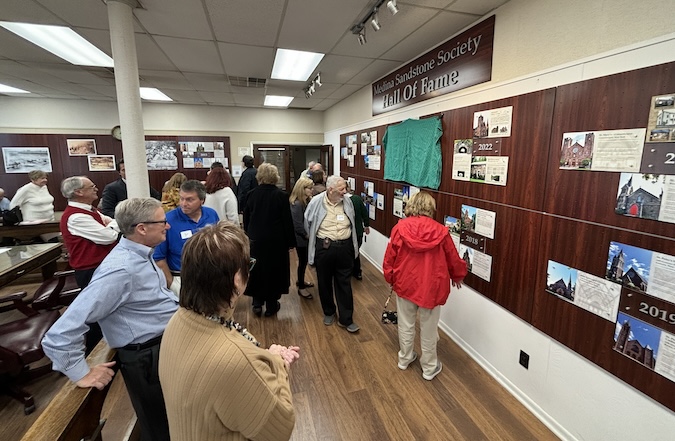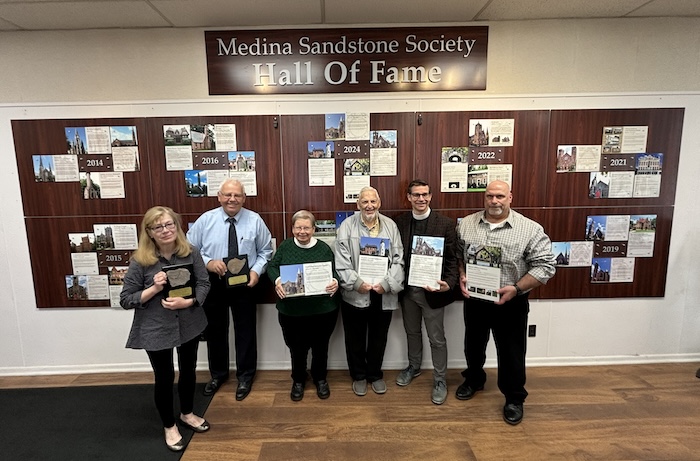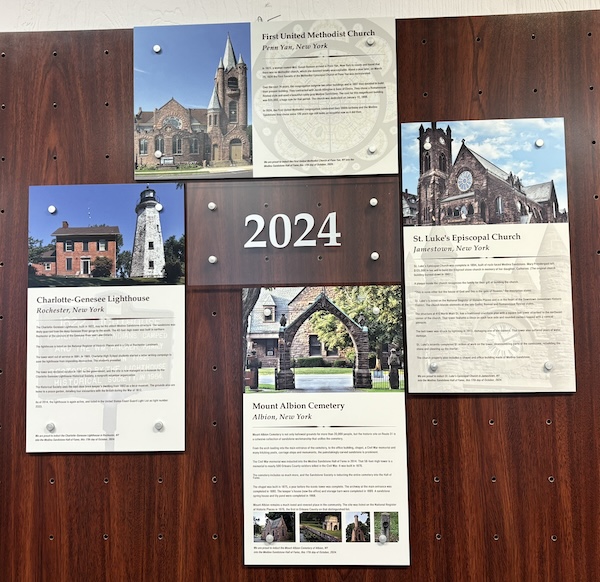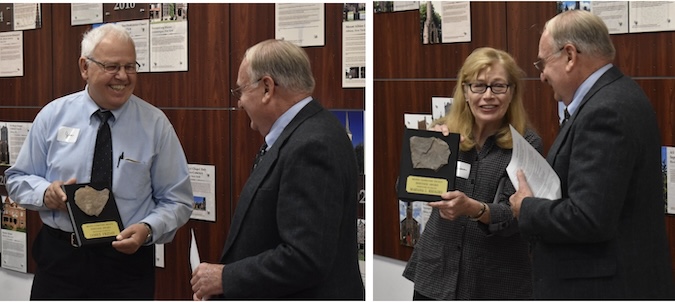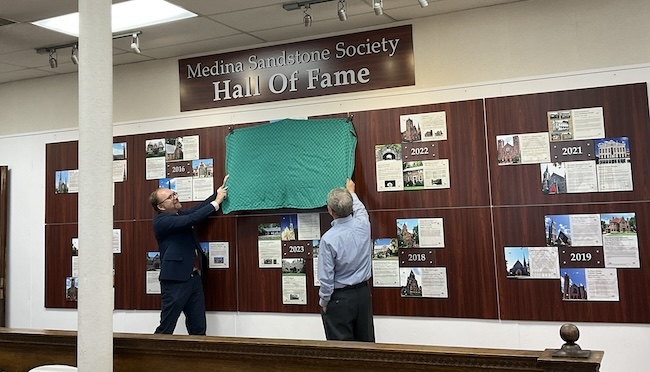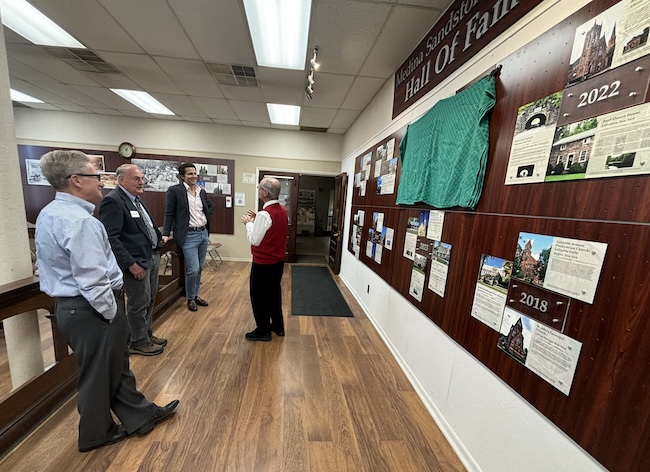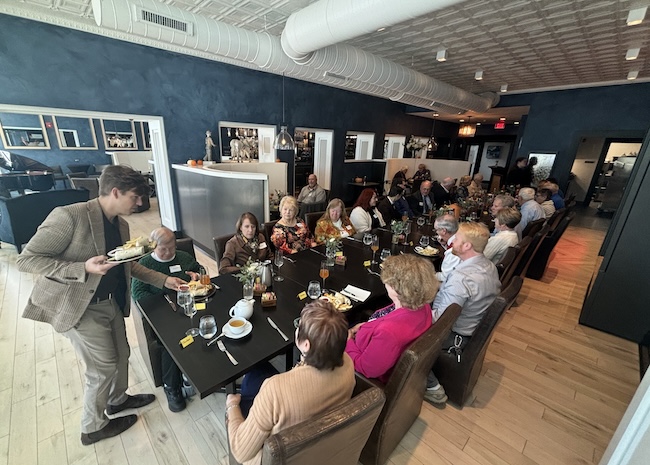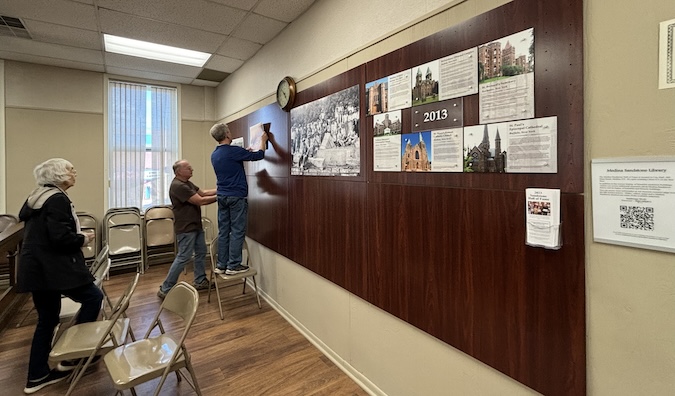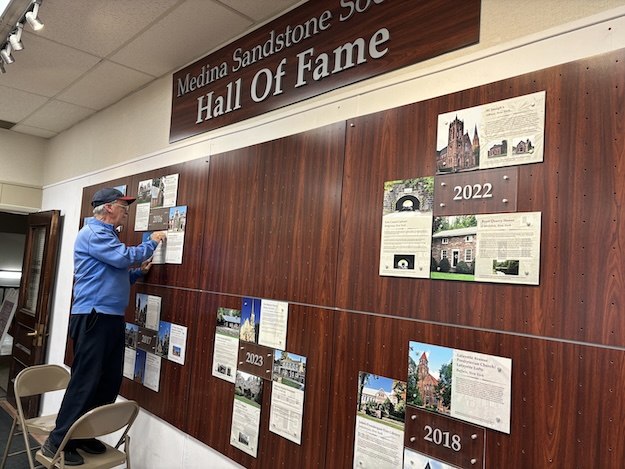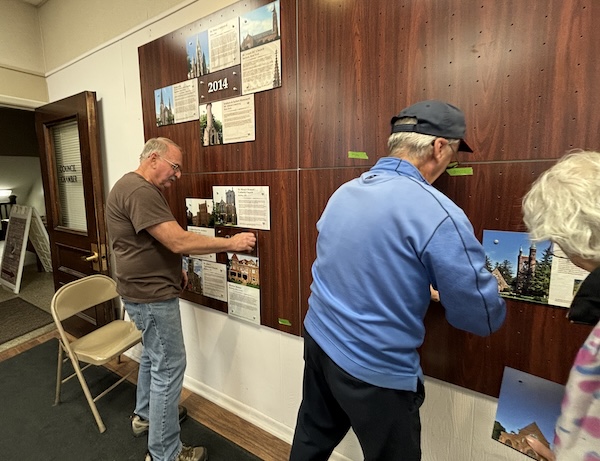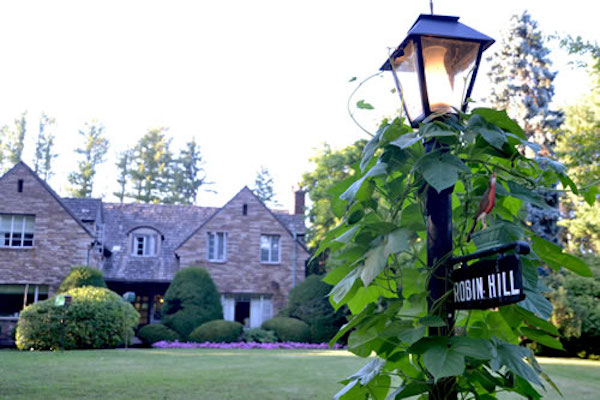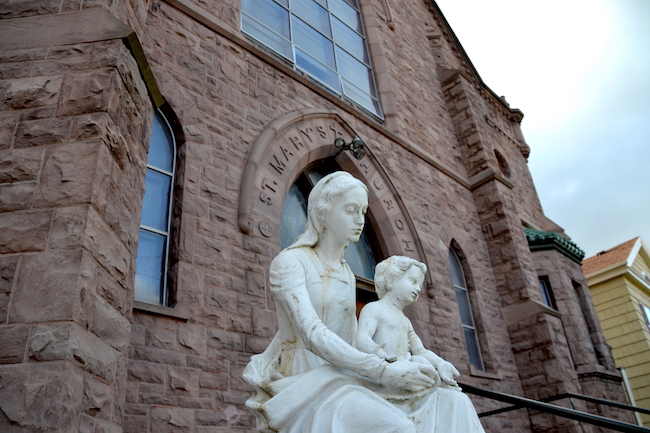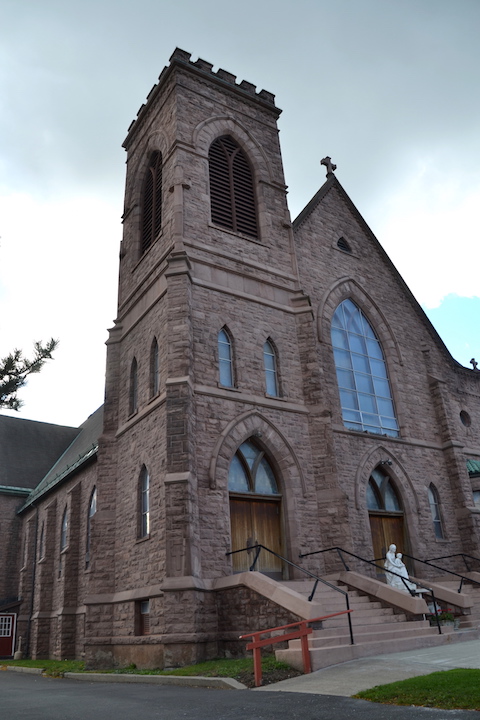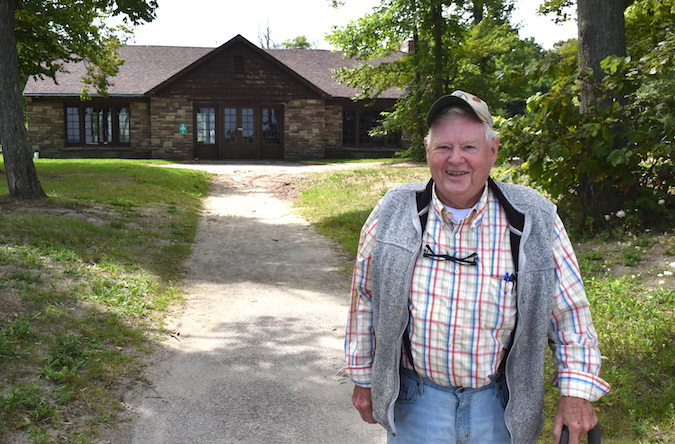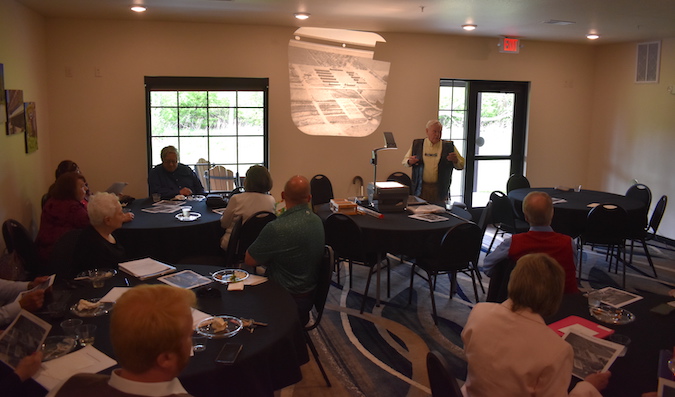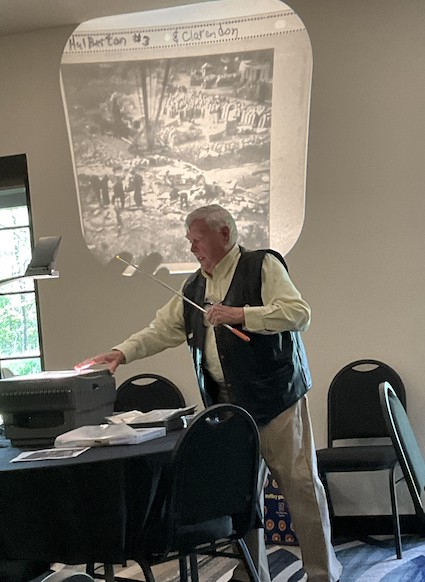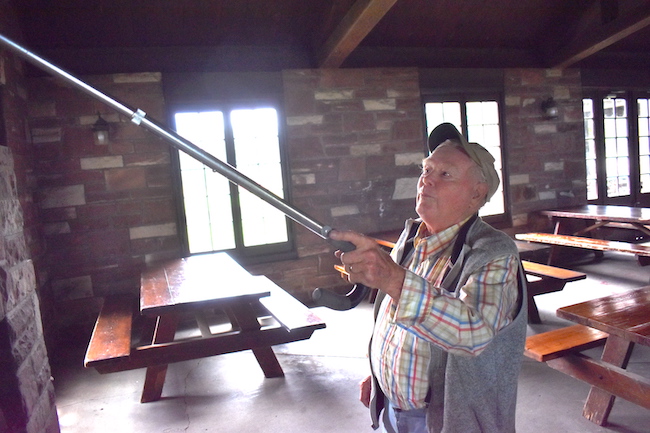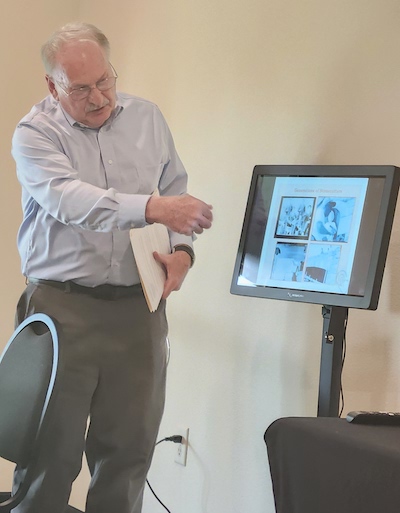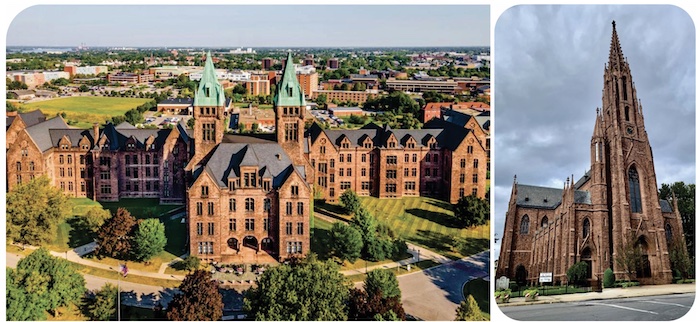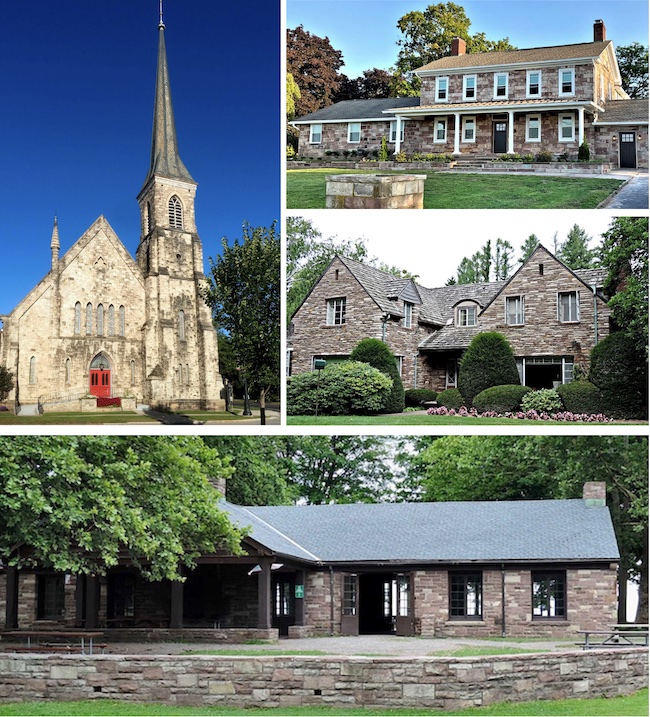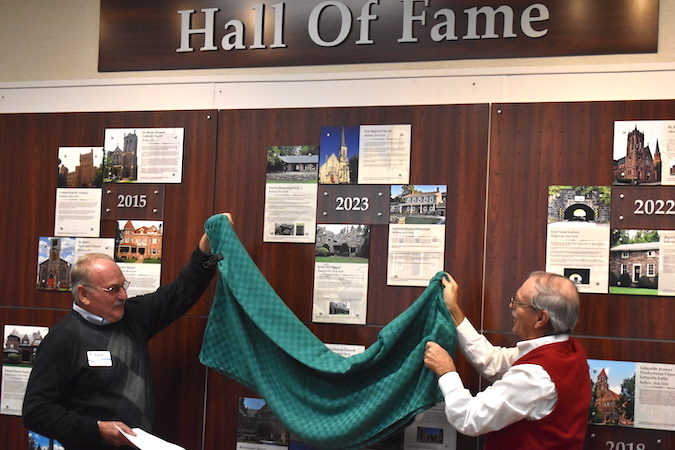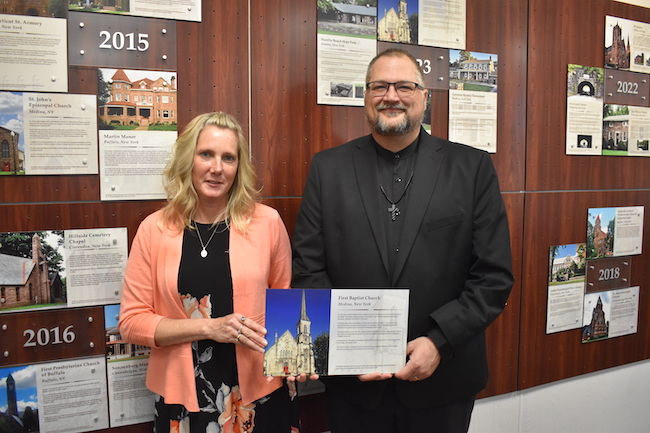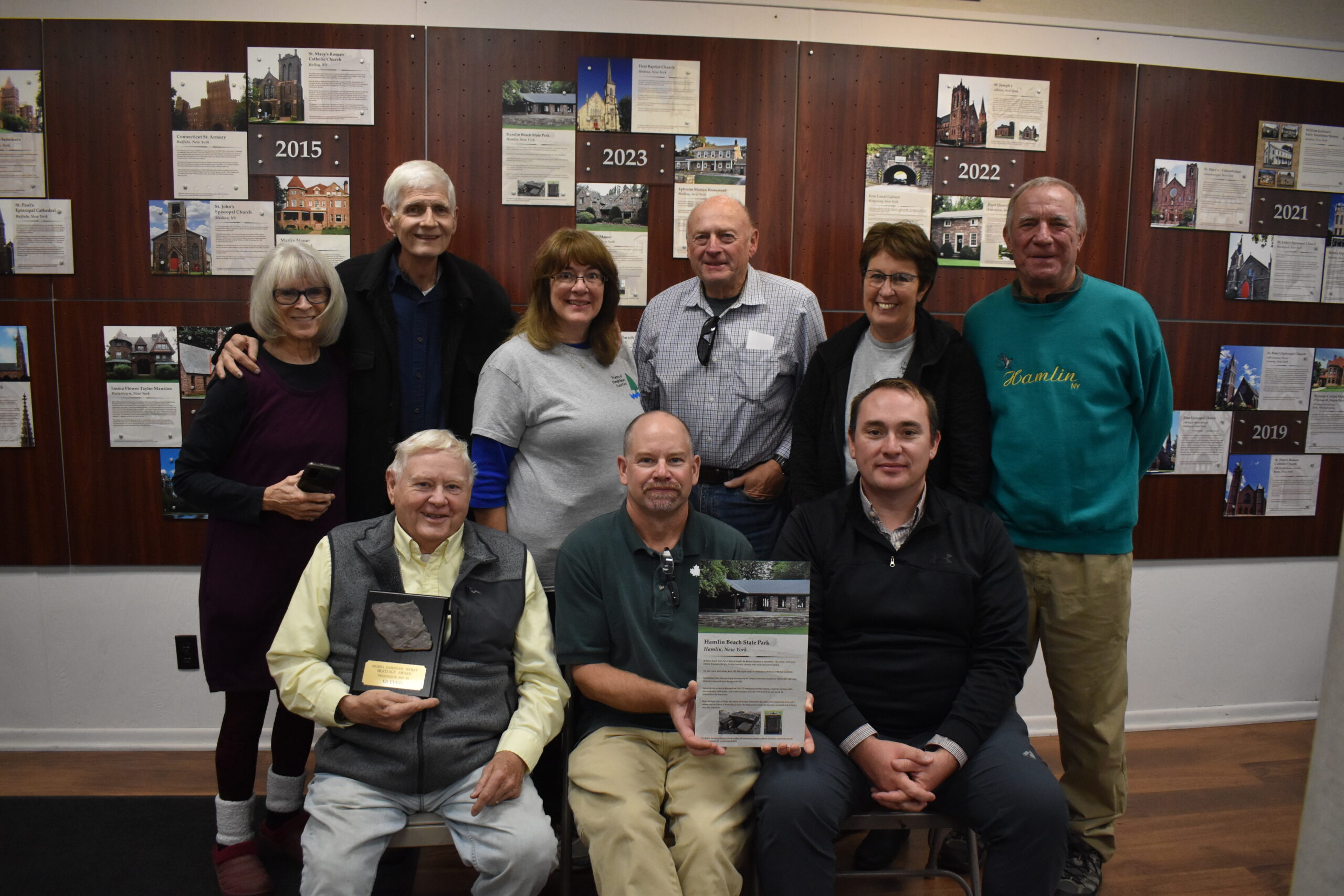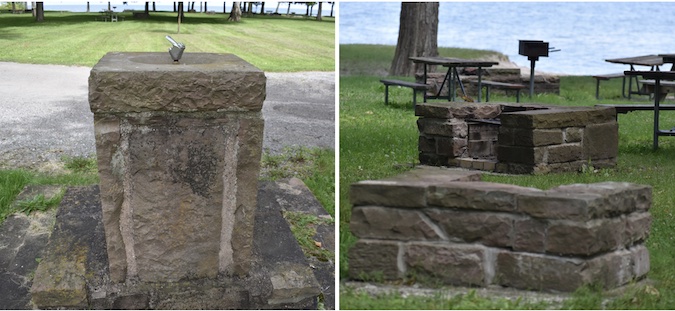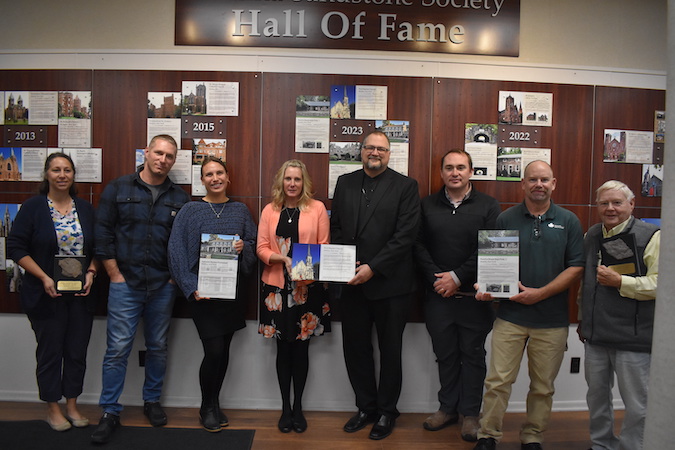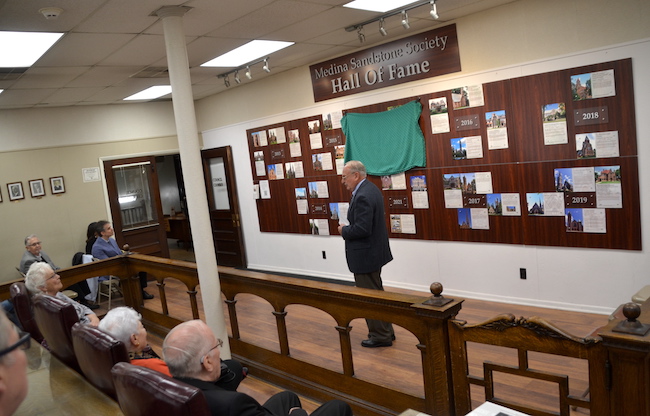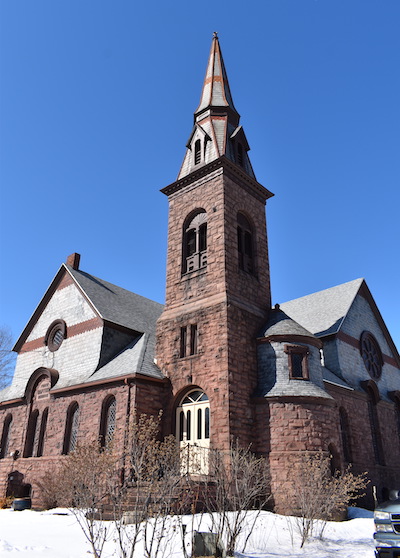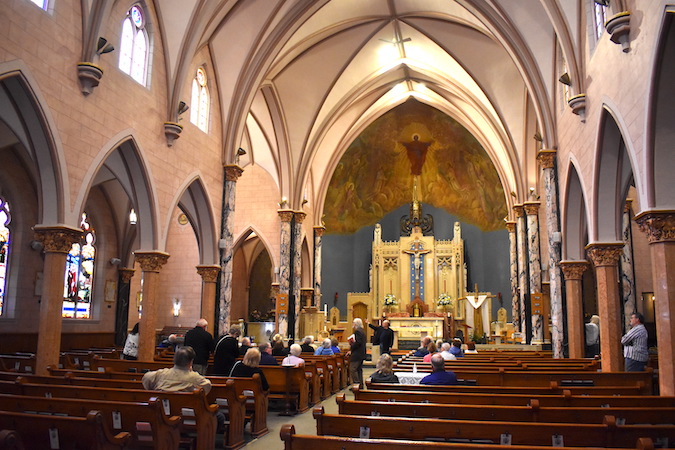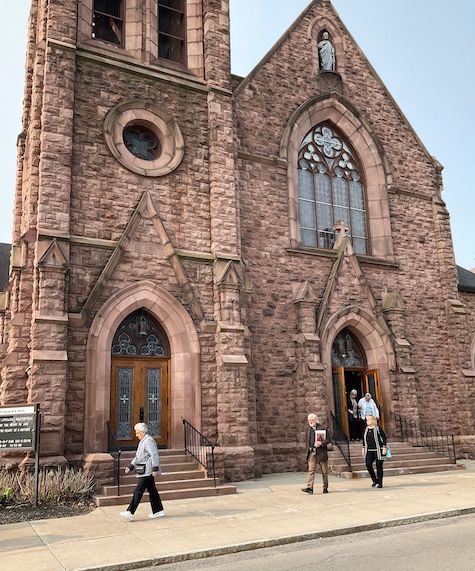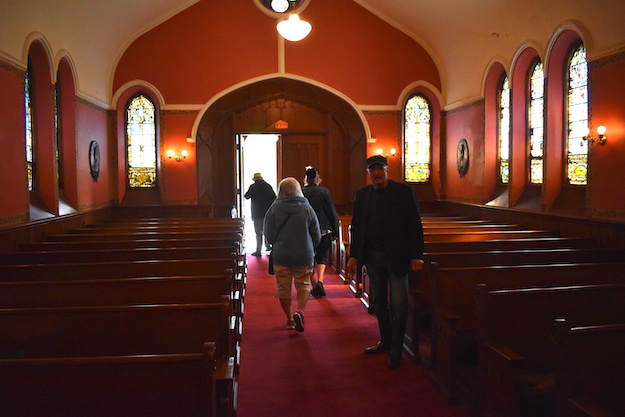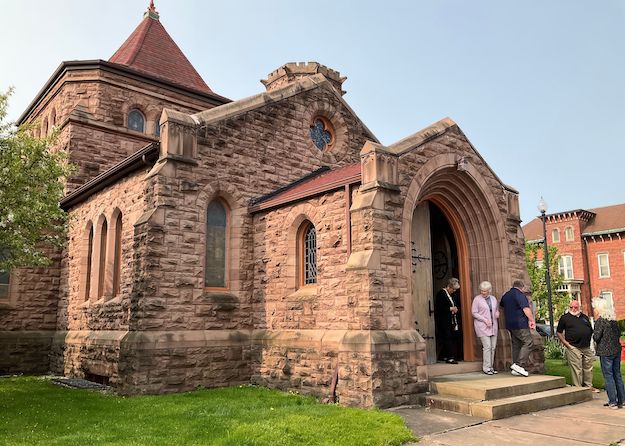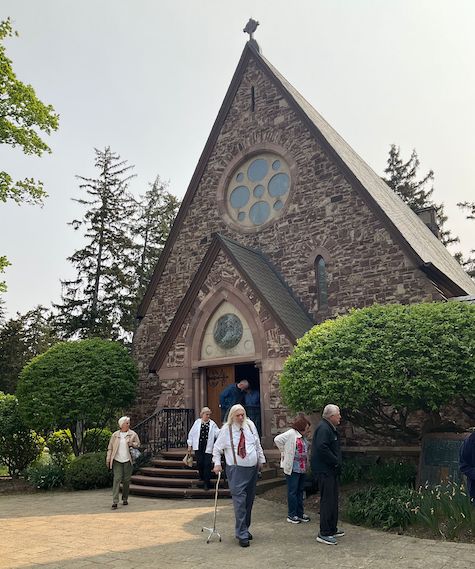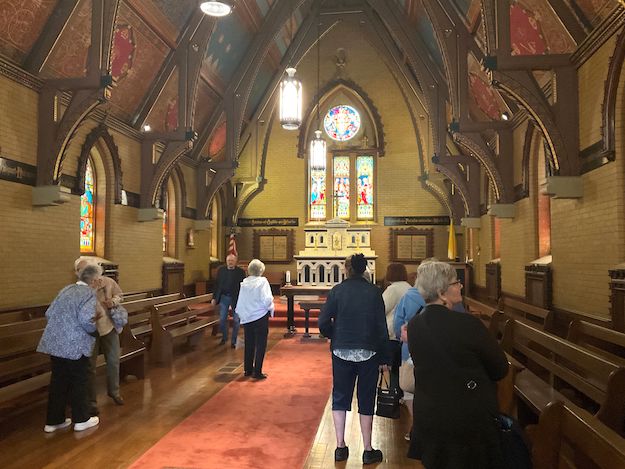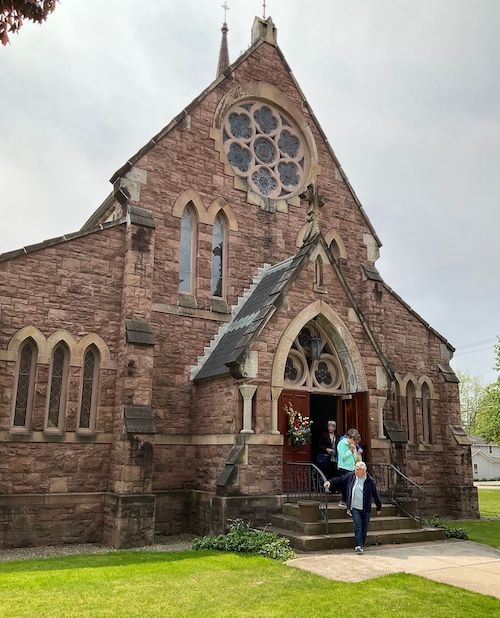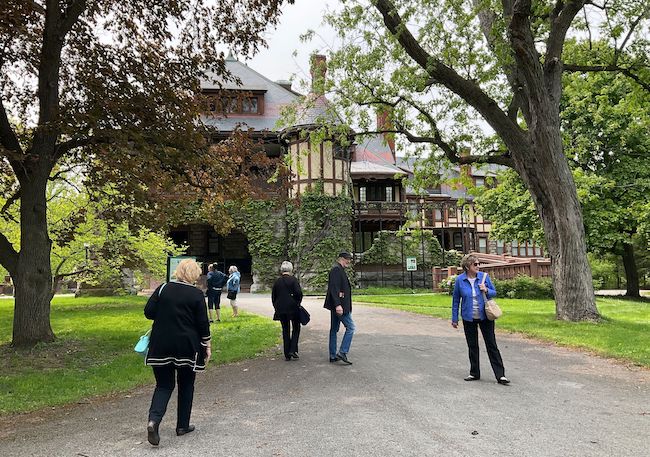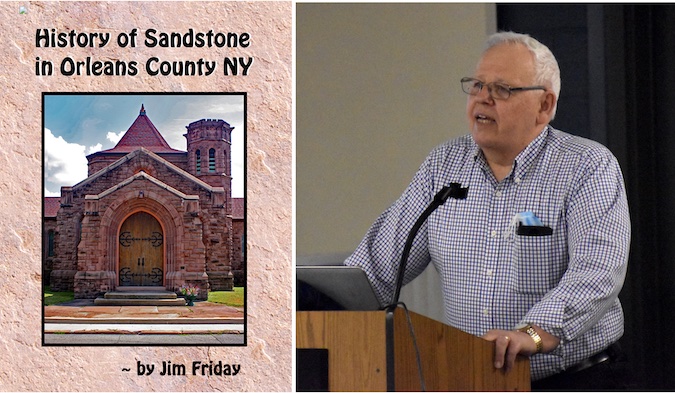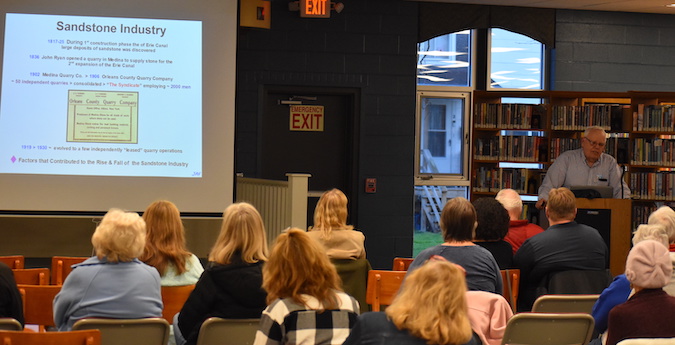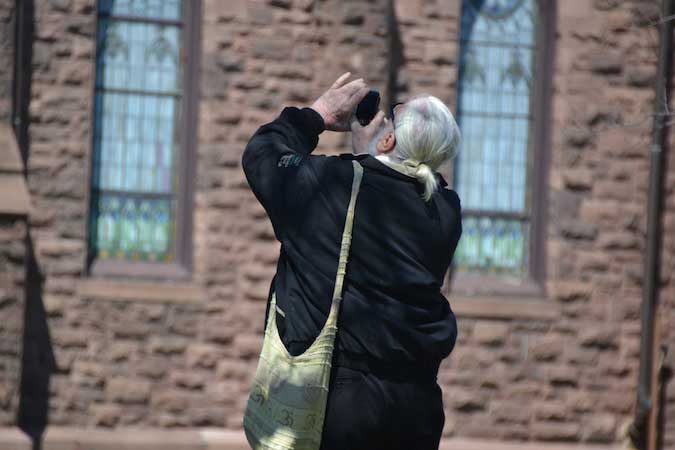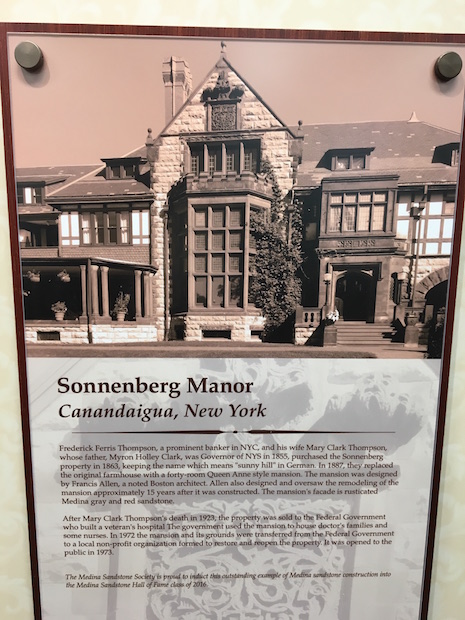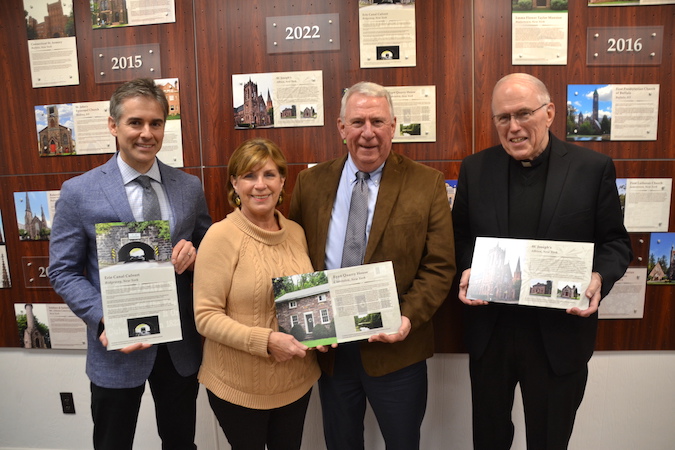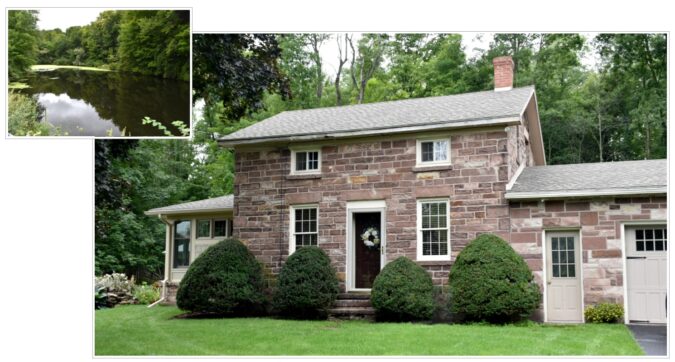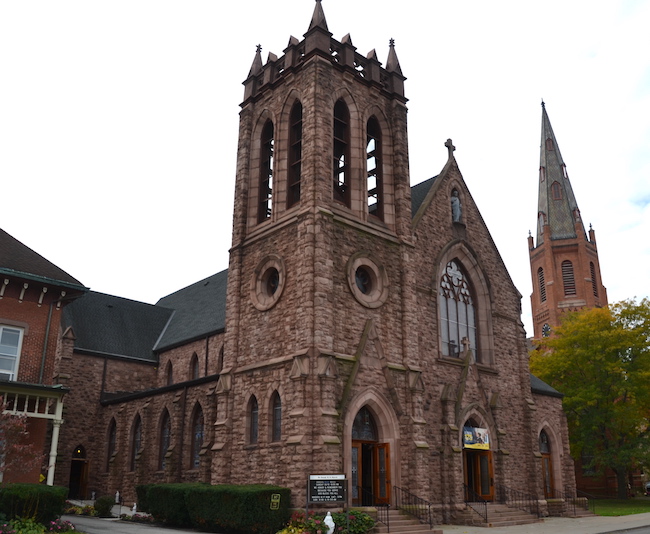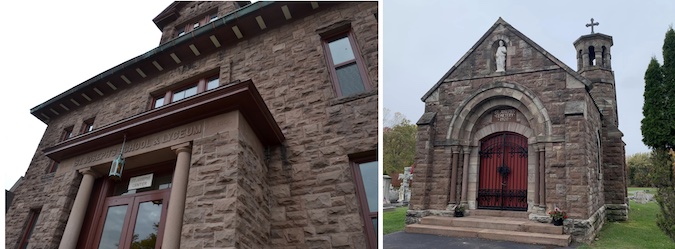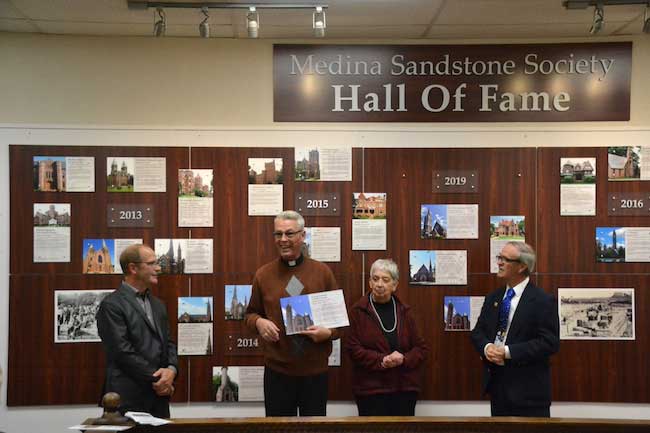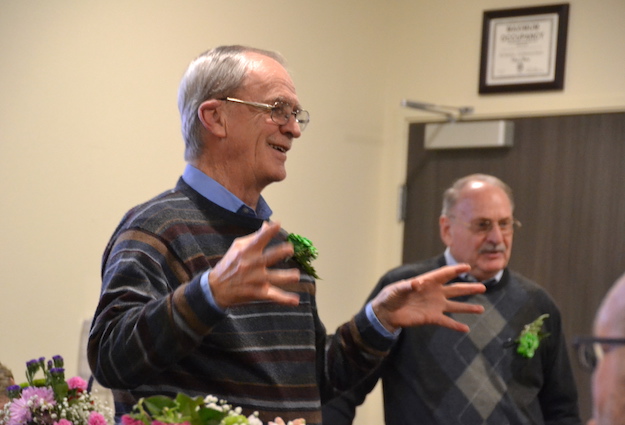4 more sites inducted into Medina Sandstone Hall of Fame
New inductees include churches in Jamestown and Penn Yan, lighthouse from 1822, and Albion’s historic cemetery
MEDINA – Four more inductees were added to the Medina Sandstone Hall of Fame on Thursday, bringing the total to 43 sites since the Hall of Fame was established in 2013.
The new inductees include churches in Jamestown and Penn Yan, Albion’s historic cemetery and Charlotte-Genesee Lighthouse. That lighthouse, built in 1822, is now the oldest structure in the Hall of Fame.
The Hall of Fame celebrates sites made of the local sandstone that have been well preserved and stand out for their architectural beauty.
The Sandstone Society also presented two Heritage Awards to people whose work and effort have contributed to the understanding and appreciation of Medina Sandstone.
The honorees during Thursday’s Hall of Fame ceremony include, from left: Heritage Award winner Mariana Rhoades, a geologist who authored definitive works on the stone industry in Orleans, Niagara and Erie counties; Heritage Award winner James Friday who a book on the sandstone industry in Orleans County; Jan Hafner, church historian for Penn Yan United Methodist; Jack Kemp, president of the Charlotte-Genesee Lighthouse Historical Society; Luke Fodor, rector of St. Luke’s Episcopal Church in Jamestown; and Jason Zicari, superintendent of Mount Albion Cemetery.
The new inductees have been enshrined in the Hall of Fame in Medina City Hall. The plaques state the following:
Mount Albion Cemetery is not only hallowed grounds for more than 20,000 people, but the historic site on Route 31 is a cohesive collection of sandstone workmanship that unifies the cemetery.
From the arch leading into the main entrance of the cemetery, to the office building, chapel, a Civil War memorial and many hitching posts, carriage steps and monuments, the painstakingly carved sandstone is prominent.
The Civil War memorial was inducted into the Medina Sandstone Hall of Fame in 2014. That 58-foot-high tower is a memorial to nearly 500 Orleans County soldiers killed in the Civil War. It was built in 1876. The cemetery includes so much more, and the Sand- stone Societyi s inducting the entire cemetery into the Hall of Fame.
The chapel was built in 1875, a year before the iconic tower was complete. The archway at the main entrance was completed in 1880. The keeper’s house (now the office) and storage barn were completed in 1881. A sandstone spring house and lily pond were completed in 1908.
Mount Albion remains a much loved and revered place in the community. The site was listed on the National Register of Historic Places in 1976, the first in Orleans County on that distinguished list.
The Charlotte-Genesee Lighthouse, built in 1822, may be the oldest Medina Sandstone structure. The sandstone was likely quarried from the deep Genesee River gorge to the south. The 40-foot-high tower was built in northern Rochester at the juncture of the Genesee River and Lake Ontario.
The lighthouse is listed on the National Register of Historic Places and is a City of Rochester Landmark.
The tower went out of service in 1881. In 1965, Charlotte High School students started a letter writing campaign to save the lighthouse from impending destruction. The students prevailed.
The tower was declared surplus in 1981 by the government, and the site is now managed as a museum by the Charlotte Genesee Lighthouse Historical Society, a nonprofit volunteer organization.
The Historical Society uses the next-door brick keeper’s dwelling from 1863 as a local museum. The grounds also are home to a peace garden, detailing four encounters with the British during the War of 1812. As of 2014, the lighthouse is again active, and listed in the United States Coast Guard Light List as light number 2333.
Penn Yan United Methodist Church – In 1823, a woman named Mrs. Susan Benson arrived in Penn Yan, New York to reside and found that there was no Methodist church, which she deemed totally unacceptable. About a year later, on March 29, 1824 the First Society of the Methodist Episcopal Church of Penn Yan was incorporated.
Over the next 74 years, the congregation outgrew two other buildings and in 1897 they decided to build their present building. They contracted with Jacob Allington & Sons of Elmira. They chose a Romanesque Revival style and used a beautiful ruddy gray Medina Sandstone. The cost for this magnificent building was $35,000, a huge sum for that period. The church was dedicated on January 12, 1898.
In 2024, the First United Methodist congregation celebrated their 200th birthday and the Medina Sandstone they chose some 126 years ago still looks as beautiful now as it did then.
St. Luke’s Episcopal Church in Jamestown was completed in 1894, built of rock-faced Medina Sandstone. Mary Prendergast left $125,000 in her will to build the fireproof stone church in memory of her daughter, Catherine. (The original church building burned down in 1862.)
A plaque inside the church recognizes the family for their gift of building the church. “This is none other but the house of God and this is the gate of Heaven,” the inscription states.
St. Luke’s is listed on the National Register of Historic Places and is in the heart of the Downtown Jamestown Historic District. The church blends elements of the late Gothic Revival and Romanesque Revival styles.
The structure at 410 North Main St. has a traditional cruciform plan with a square bell tower attached to the northeast corner of the church. That tower features a clock on each face side and rounded corners topped with a conical pinnacle.
The bell tower was struck by lightning in 2013, damaging one of the corners. That tower also suffered years of water damage.
St. Luke’s recently completed $2.5 million of work on the tower, disassembling parts of the sandstone, rebuilding the stone and cleaning up the mortar.
The church property also includes a chapel and office building made of Medina Sandstone.
Dave Miller, a member of the Hall of Fame Committee, presents Heritage awards to Jim Friday, left, and Mariana Rhoades, right.
Their plaques include a sliver of Medina Sandstone. The writeups about them include:
Mariana Rhoades is a researcher with an MS degree in sedimentary geology from the University of Rochester. She taught geology for over two decades at St. John Fisher College and SUNY-Empire State College as well as through other continuing education programs at Nazareth College and the Roads Scholar offerings.
Rhoades has authored several papers on stone materials for the Erie Canal, California sandstones and other general geology topics.
Her most recent publication which was published last year is the “Stone Industry in Orleans County, 1820-1930.” It comes in the form of a CD and a USB flash drive. This definitive 1,517-page work documents virtually every quarry in this historic local industry. It also documents lime kilns which produced the mortar used by masons for construction.
Her work includes:
- A list of owners of the quarry/kiln
- New York state and federal census information for quarry owners
- Web information on the quarry owners
- Maps with description where the quarry/kiln was located
- Bedrock at the site of the quarry/kiln
- Structures where the extracted stone was used
- History books and manuscripts describing the quarry/kiln
- Newspaper articles describing the quarry/kiln operations
- A time-line of quarry operation and its owners
She has also published similar works for Erie and Niagara counties and she is currently researching Rochester with that publication due next year.
Dave Miller, a member of Hall of Fame Committee, presented the award to Rhoades.
“We want to recognize your invaluable contributions and the impact you’ve had in preserving the history and heritage of our community,” Miller said.
James Friday is a Kodak retiree who loves local history. In 2021 he completed and self-published his book about the local sandstone industry entitled “The History of Sandstone in Orleans County NY.”
The 108-page book includes many photos of the county’s dominant industry. In the book he explores the geology of how and when the stone was formed, the rise and fall of the regional quarry industry and what remains today.
Friday is a descendant of Polish immigrants who lived in Albion. When he was a child, he spent a lot of time in that village and often swam in the village’s quarries.
At the present time Jim also serves as the coordinator of the orleans.nygenweb.net website that includes a wealth of local genealogy data about Orleans County families.
“Given the significant size and importance of the sandstone quarry industry in our county, it’s surprising how little has been documented about its history,” Miller said. “That’s why we are especially grateful to you for publishing this much-needed account about this part of our local heritage.”
Hall of Fame Committee members Tom Rivers, left, and Reinhard Rogowski pull the curtain to show the new inductees.
Mike Hungerford, third from left, is co-president of Takeform in Medina, which donated the plaques for the Hall of Fame and also for the inductees. Others in photo include HOF Committee members Reinhard Rogowski, Dave Miller and Jim Hancock. Takeform has donated the plaques for all 43 inductees in the Hall of Fame since 2013.
Justin Bruce, restaurant manager at Bent’s Opera House, serves food for 31 people who attended a Hall of Fame luncheon at Bent’s, a building that was inducted in the Hall of Fame in 2021.



















